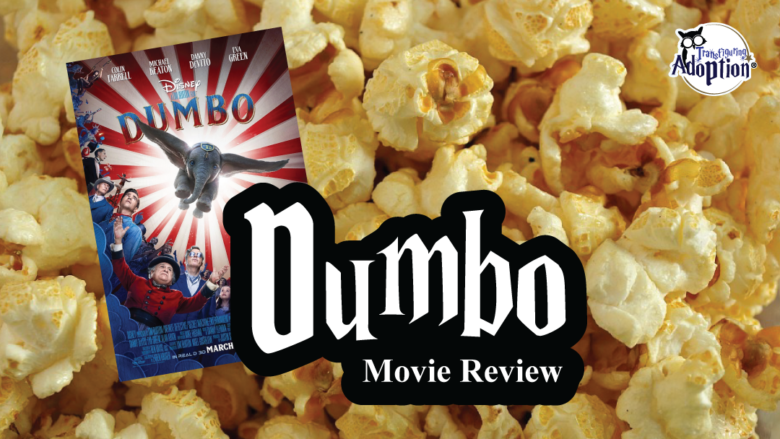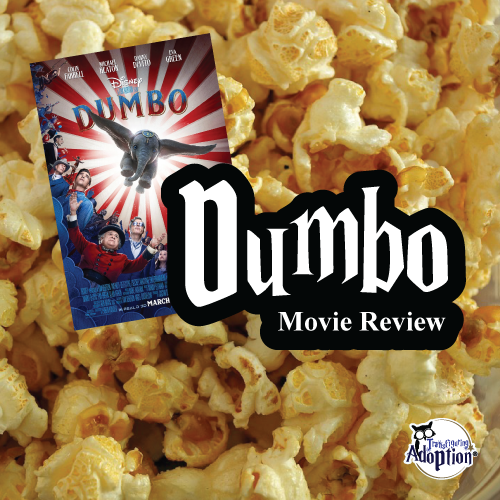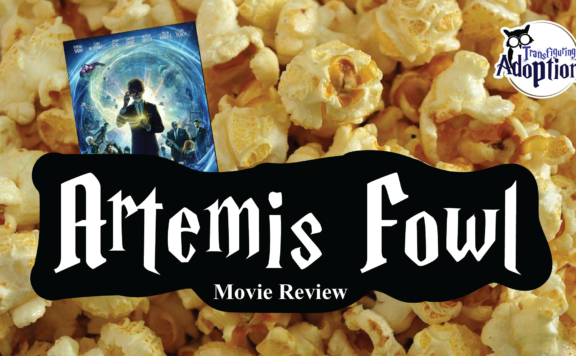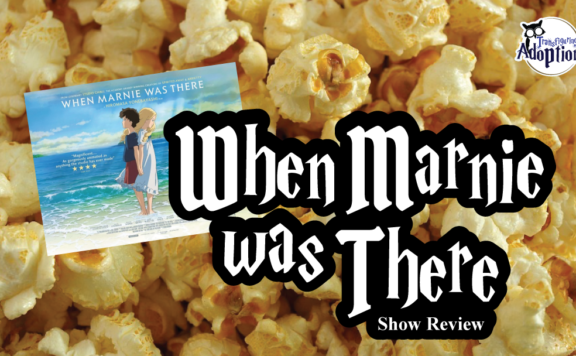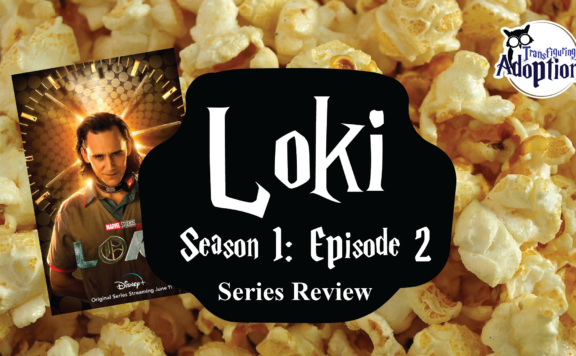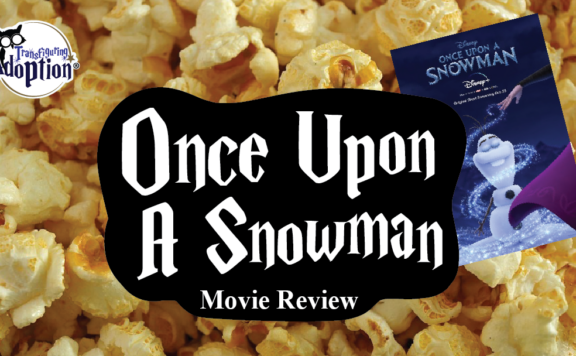Grade:
Transfiguring Adoption awarded this book 3 Hoots out of 5 based on how useful it will be for a foster/adoptive family. [Learn more about our Hoot grading system here]
Movie Info:
- Rating: PG (for peril/action, some thematic elements, and brief mild language)
- Genre: Animation, Kids & Family, Science Fiction & Fantasy
- Runtime: 112 minutes
- Studio: Walt Disney Pictures
From Dumbo (2019) by Walt Disney Pictures:
“From Disney and visionary director Tim Burton, the all-new grand live-action adventure “Dumbo” expands on the beloved classic story where differences are celebrated, family is cherished and dreams take flight. Circus owner Max Medici (Danny DeVito) enlists former star Holt Farrier (Colin Farrell) and his children Milly (Nico Parker) and Joe (Finley Hobbins) to care for a newborn elephant whose oversized ears make him a laughingstock in an already struggling circus. But when they discover that Dumbo can fly, the circus makes an incredible comeback, attracting persuasive entrepreneur V.A. Vandevere (Michael Keaton), who recruits the peculiar pachyderm for his newest, larger-than-life entertainment venture, Dreamland. Dumbo soars to new heights alongside a charming and spectacular aerial artist, Colette Marchant (Eva Green), until Holt learns that beneath its shiny veneer, Dreamland is full of dark secrets.”
Transfiguring Adoption’s Overview:
Dumbo (2019) flies into the hearts of another generation 78 years after the 1941 animated film of the same name. However, this movie is not merely a remake of the musical caregivers may remember from their own childhood. Tim Burton mans the helm of this more mature project to bring a new twist on the beloved story. The musical soundtrack also provides an update with musical scores by Danny Elfman.
In this film we see Dumbo’s story progress alongside his caretakers’ post-war reunification. Holt Farrier has been away from children, Milly and Joe, for a long time due to fighting in World War I. Upon his return, he discovers that his circus horses were sold to support the struggling circus after Holt’s wife (and costar) Annie passes away from Spanish Flu. The children find that not only is their father missing an arm, but experiences in the war have changed him. The film follows the father and children learning to connect again after significant loss as well as their coming together to care for Dumbo and eventually reunite him with his mother.
** Spoilers Could Be Ahead **
How Is This Relevant To Adoption & Foster Care?
Two of Dumbo (2019)’s biggest themes throughout the film are reunification and adjusting to significant, dynamic changes in family systems. Holt returns from the war and struggles to connect with his children following a long absence and the death of his wife, the children’s mother. Dumbo is separated from his mother after she is sold to prevent a public relations disaster in the media and then eventually reunified with her. Holt must find gainful employment after losing his arm to provide for his family. Molly and Joe must be true to themselves while still helping what remains of their family to survive.
While a caregiver’s home may not be a literal circus, there are days it certainly feels like a caregiver is a Master of Ceremonies for a 3-ring stage for sure. Juggling the home functioning, the ever-changing emotions of foster/adoptive children, supporting biological children, maintaining self-care, tackling all the various appointments required for children in care, workers coming in and out of the home… and SO MUCH PAPERWORK. This is because each family member is not an isolated unit within the home. The triumphs and struggles of each family member affect the unit as a whole. For this reason, though the film does not directly address Foster Care, Dumbo (2019) can be used as a useful discussion tool to help foster children talk through the multi-faceted subject that is reunification as well as how one person’s struggle is actually the whole family’s challenge and can be tackled together.
Discussion Points:
- Reunification
One of the most heartbreaking moments of the film was watching Mrs. Jumbo be sold and Dumbo being left behind. The emotion can only be matched by the joy in seeing Dumbo and Mrs. Jumbo reunited by the end of the film. For various reasons the children in our care are brought into the child welfare system, and upon reunification, it is up to the parents and children to work together and use their newfound resources and supports to learn to live together again and form a stronger bond than before removal. While reunification can be a joy (such as for Dumbo and Mrs. Jumbo), as we see with Holt and the children, reunification can also be hard and require a lot of time and work to adjust successfully. This movie can help children talk through some of the unexpected challenges (along with the joy) “going home” can bring. - Family Systems Dynamics
Often when we go through a struggle we feel alone, isolated in the pain and struggle. However, even though only the individual goes through a primary trauma, the rest of the family can experience the effects of secondary trauma exposure, meaning experiencing trauma from residing with a traumatized individual. Knowing that a family is affected by each individual can help a child feel less alone but also help a foster family wrap around as a support for the child without being pulled under by intense emotional swells. Annie Farrier’s death affected each member of the family intensely and uniquely, but Holt and the children were able to come together in the struggle to support one another and forge a stronger bond than before upon realizing they no longer had to suffer through the pain of loss alone.
Cautionary Points:
- Overall Mature Tone
Caregivers, at this point we all know that just because something is animated (or Disney), that does not mean that the story will automatically be happy and sunny. However, this film has much less whimsy to balance intense emotional plot compared to the 1941 film. The film also may be too mature for younger children to understand and enjoy, so it is advised to think about a child’s developmental level as well before viewing the movie with younger family members. - Traumatic Separation of Parent and Child
Children in foster care have suffered immense loss unique to their cohorts. Every child in care experiences some level of trauma due to the removal from their family of origin, if not more loss from parents absent due to addiction, mental health challenges, incarceration, or even death. Caregivers should be sensitive to how a child may respond to seeing Dumbo forcibly separated from his mother for this reason. - Unrealistic Expectations of Reunification
While Holt’s reunification with Milly and Joe does a fantastic job of showing how reunification, while absolutely a goal for families we should encourage, can have challenges unique to a family that must reforge bonds and learn to live together again, the reunification of Dumbo and Mrs. Jumbo may portray a fantasy narrative for foster children. - Animal Handler Killed by Mrs. Jumbo
The handler in question was a highly abusive character who was very cruel to the animals, especially the elephants. While Mrs. Jumbo rushes in to defend Dumbo from the mocking crowds, she accidentally kills the handler in the chaos. This may be traumatic for children who have witnessed accidents that have resulted in loss of human life.
Discussion Guide:
- Why were Milly and Joe shy to greet their father at the train station?
Caregiver Note: Traumatic events may or may not leave physical scars like Holt’s amputated arm. For Milly and Joe, it was difficult to take in a vision of their father that was different from the one in their minds. In addition to Holt’s physical reminder of his time served in war, the children also notice that he acts differently, gruff and distant from years of high stress and grief. Trauma can affect how someone acts and even responds to affection. This can be a great discussion to talk about how invisible scars provide a challenge for bonding. - Why was Holt trying so hard to hold on to the circus life in spite of the push back from his children and Max Madici?
Caregiver Note: Holt fought through a long, hard war and as a result, lost his arm, jeopardizing future employment as an equestrian performer. He also lost his beloved wife and costar to illness while he was away. Holt is certainly holding a significant amount of trauma compounded by the stress of needing to provide for the family he has left. When people are under immense stress, they often seek comfort in something familiar. Emotional eaters turn to favorite foods, small children scream for a favored toy or blanket as a comfort object, and adults often immerse themselves in experiences that help them escape from stress. This can be an excellent question to open discussion about what things children or youth may cling to for comfort, which will help caregivers in more accurately reading non-verbal communication in behaviors. - How do you think Dumbo felt after his mother, Mrs. Jumbo, was taken away? Have you ever felt like that? What did you feel? How did you act?
Caregiver Note: This question can open up discussion to give names to emotions. Children or youth may or may not feel comfortable with talking about a removal situation, so let this discussion go strictly at the child or youth’s pace. If the child wishes to focus on another perceived loss, this is okay too. The bigger take away for this question is to help the child or youth in connecting words to feelings, then feelings to behaviors, not to potentially re-traumatize the child. You may want to solely talk about Dumbo and his feelings if you feel it may be too traumatic for your child to talk about their own caregiver separation(s). - Why do you think Dumbo needed a feather to fly?
Caregiver Note: As adults, caregivers may already know the answer to this. Sometimes when things seem daunting and scary, we recreate situations to help us cope with the stress. Don’t believe me? Think about your friend who wears their lucky jersey for his team’s football games or your college roommate who had a lucky pair of underwear for exams. Do these lucky charms or rituals actually cause the team to win or the roommate to pass the exams? Not directly, but with a boost of confidence from that charm or ritual being in place, it may help how a person experiences the event. This is the same for Dumbo, who uses his ears to fly and not a magical feather at all. Children or youth in care may sometimes have rituals or their own “lucky charms” that caregivers may need to have sensitivity towards. Open up a discussion about such things that help relieve stress and tension for your child or youth. - Activity: Lucky Feather
Caregiver Note: For this activity you will need an assortment of larger feathers (yours and the child’s choice of colors or types), string strong enough for a necklace, beads, glue, and colorful objects that can be glued onto the feather. Use the materials to make a feather necklace with your child. Discuss with your child how Dumbo used the feather to get himself through the impossible task of flight. Allow your child to have access to the feather necklace and use the necklace to communicate non-verbally when they need more support when dealing with the impossible. - Why did Colette and Dumbo need safety nets even though they practiced over and over again? What sort of “safety nets” do you need sometimes?
Caregiver Note: Children and youth in care are often tasked with developing coping skills with their therapists and case workers to help them cope with stressful events, intense emotions, and unsafe behaviors. These skills are discussed in sessions and practiced often to help a child administer these skills to slow down and think through their feelings and behaviors rather than be carried away by impulse. Coping skills are very important for the individual, but in the timeframe of learning what coping skills are most effective, children may need help co-regulating their emotions, meaning having help from an adult to bring calm to the chaotic mind. Help your child or youth think of “safety nets” you can provide as a trusted adult to help when the feelings get too big and a bigger net is needed to protect your child or youth. - How did all the circus performers use their differences to save Mrs. Jumbo? What’s something only you can do that could help someone?
Caregiver Note: Throughout the film it’s evident that the Medici Brother’s Circus is home to several performers that are considered societal outcasts. However, while each performer has something that makes them stand out from other people physically, each of them also has traits that help them save Mrs. Jumbo. Children or youth from care may feel that they have something about them that makes them different and isolated from their peers. For example, some youth may struggle with their identity as a foster youth and the disruption in normalcy they have experienced. However, with that difference maybe that child has developed compassion and empathy for others who have gone through loss or a youth has developed a wicked sense of humor that can be used to cheer up others who are hurting. Though we don’t wish trauma on anyone, a child or youth learning to take the parts of them that have grown in adversity and use them for something positive can promote better self-esteem and overall wellbeing as a result. - Milly throughout the film sticks out from the circus performers and her father because of her interest in science and the scientific method. How does she use her interest in science to help her father, Holt?
Caregiver Note: This is another question that can help children with the concept that different does not mean “bad.” Throughout the film, Holt struggles to understand his daughter’s deviance from the family business of circus performance in favor of experiments and the scientific method. Because he has so little exposure to STEM subjects ,he fails to see how rats and flags can connect to his world. Milly finding a way to communicate connection and care for her father provides a strong moment for the two to imagine how science could influence their family for the better. This question can help children or youth think through ways they can communicate using things they care about such as music, food, favorite subjects in school, etc. and even potentially expand their interests or hobbies. - What changes came to the Medici Circus because of Dumbo and the Farrier family’s advocacy?Caregiver Note: It’s important for children and youth to learn not only to self-advocate but also to think through desired outcomes for change. After the events at Dreamland, the audience sees that the circus no longer uses wild animals in captivity for entertainment, and Vandevere is arrested and tried for his shady business dealings concerning the animals in his care. This means that the Farrier’s not only were able to help Dumbo and Mrs. Jumbo but circus animals as a whole to return to the lives they were meant to live. And because of the restructuring, the Farriers were also each able to pursue their dreams and thrive as a family.
- How do you think Dumbo and Mrs. Jumbo will survive in the wild? What kinds of challenges and wins may they experience in the wild compared to living in captivity in the circus?
Caregiver Note: This is a great question to help children and youth think about the journey home for cases in foster care that are going to reunify. As an audience to a Disney film, we only see Mrs. Jumbo and Dumbo enjoying life out in the wild, and while this is a good ending for a movie, there may be unseen challenges for two elephants who have potentially never lived in the wild together. Explore the different challenges they could face and how their strengths could benefit them in facing these challenges for a strength-based discussion.
Buy From Our Links and Support New Projects:
Transfiguring Adoption is a nonprofit organization seeking to nurture growth in foster and adoptive families by giving a HOOT about their families. Transfiguring Adoption does not intend for its reviewers nor its review to be professional, medical or legal advice. These reviews and discussion guides are intended to help parents to better be able to connect and understand their children who come from traumatic backgrounds.
